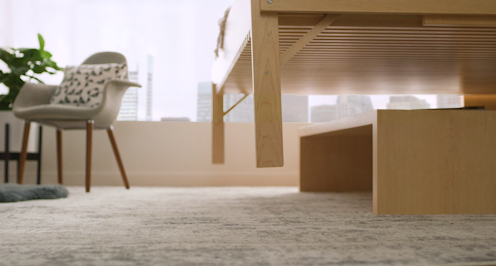'Transformer' rooms and robo-furniture are set to remake our homes – and lives – before our eyes
- Written by Christian Tietz, Senior Lecturer in Industrial Design, UNSW

With two-thirds of a global population of 9.4 billion people expected to live in urban areas by 2050, we can expect a change in the domestic living arrangements we are familiar with today.
In high-density cities, the static apartment layouts with one function per room will become a luxury that cannot be maintained. The traditional notion of a dedicated living room, bedroom, bathroom or kitchen will no longer be economically or environmentally sustainable. Building stock will need to work harder.
The need to use building space more efficiently means adaptive and responsive domestic micro-environments will replace the old concept of static rooms within a private apartment.
Read more: Urban density matters – but what does it mean?
These changes will reframe our idea of what home means, what we do in it, and how the home itself can support and help inhabitants with domestic living.
So how will these flexible spaces work?
Sidewalk Labs and IKEA are collaborating with Ori, a robotic furniture startup that emerged from the Massachusetts Institute of Technology, to transform our use of increasingly sparse urban living space. They have developed ways to enhance existing apartments with pre-manufactured standardised products to make living spaces flexible.
Leading product designers have produced tantalising concepts of how these newly developed products could enhance our lives in cities where space is at a premium. One example is based on a floor plan measuring just 3m by 3.5m.
Yves Béhar and MIT Media Lab’s design for a robotic furniture system for small apartments, which reconfigures itself for different functions.The more intensive use of building space with hyper-dense living will have impacts on circulation spaces. It will require more services in tighter spaces and a vigilant eye on emergency evacuation pathways. Public space will be much more crowded and play a more important role in our well-being.
Read more: People-friendly furniture in public places matters more than ever in today's city
The robotic furniture that is available now could also help people with some form of impairment negotiate their home environment. An example is a bed that tilts up into a position that makes it easier to get out.
Some furniture now on the market has similar mechanically assisted functions to help people get out of a chair. This can be expanded into a broader range of facilitated living aids for people with physical and other impairments.
Ease of transformation is the key
Mobile furniture is not a new idea. The late 1980s and early 1990s spawned a whole range of mobile furniture, such as tables on wheels and sideboards with castors.
We have always tried to make rooms adaptable. Japanese screens or room dividers were one way. We have space-saving and transforming furniture from IKEA such as folded-up hallway tables that can become dining tables.
The idea of being able to transform our living space made these mobile furnishings enticing. But they all required a range of manual actions and this effort meant that, after a few initial experiments with them, they ended up in one static position. These mobile items became integrated and firmly located within the accumulations of things that make up our private sphere and who we are.
Read more: Reinventing density: co-living, the second domestic revolution
Industrial designers such as the late Luigi Colani designed pre-manufactured dwellings with rotating interiors – but the ease of transformation is what really makes a difference now. It’s likely to have reverberating effects.
Luigi Colani’s Rotor House.The term robotic furniture conjures up Jetsons-like images, but what this means is we will have adaptive spaces. Rooms will transform from bedroom into living room or from study into entertainment space at the touch of a button, a gesture, or a voice command.
While the videos (above) of beautifully designed spaces make the idea tantalisingly attractive, we need to bear in mind these are initial concepts, even though well-developed. But this heralds the beginning of an entirely new way of conceiving and inhabiting space. We have reached a time where everything is in flux.
The Ori Cloud Bed in action.It introduces another element into our daily routine. The time it takes for the transformation to be completed plays a big role. Too slow and we think twice about it, too fast and it might knock a few things about. In the examples shown (above) they are workable and safe.
If we take this development a step further, the way our cupboards store and provide access to our things might be next in line for robotic optimisation.
It’s not just rooms that will be transformed
There are still questions to be answered. For example, will the speed of the spatial transformation taking place influence the speed of our personal routines, like the time we allow for our morning coffee routine before heading out the door?
How will these new flexible spaces affect our sense of belonging and feeling at home, when everything can change with a voice command?
Read more: Control, cost and convenience determine how Australians use the technology in their homes
Robotically optimised homes might change culture in similar ways to how digital communications altered our conversations, social conduct, personal relationships, and behaviour.
The way we think about building and living in high-rise apartments, which we have done for hundreds of years, is about to take a turn. It could transform how we conceive of and inhabit vertical space.
Existing building typologies and the ways and means of how buildings are designed and developed will change entirely. This has the potential to have a massive and disruptive impact on real estate development, building design and regulation, construction methods, housing and social policy.
Authors: Christian Tietz, Senior Lecturer in Industrial Design, UNSW



